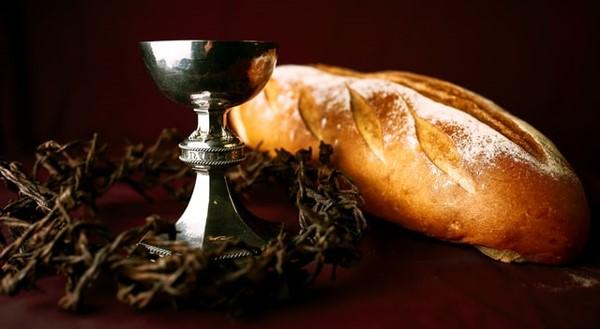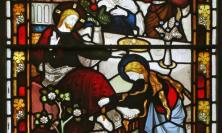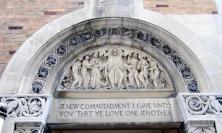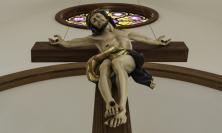A series of Sunday gospels from Mark is interrupted in year B by a collection of readings from chapter 6 of John’s Gospel, in which Jesus speaks of himself as ‘the bread of life’. Peter Edmonds SJ takes us through this section of John’s Gospel and explains how it functions as a homily, referring to and weaving together a rich assortment of Scriptural texts.
Mass-goers in year B of the lectionary cycle, when Mark is the gospel regularly read on Sundays, might be taken aback on the 17th Sunday of the year when John’s Gospel takes over once the story comes to the feeding of the five thousand. For the following five successive Sundays, we have readings from John 6.[1] It is worth our while to find time over this five-week period to tease out what the evangelist is doing as he expands material to which Mark devotes just ten verses. In John, it is the longest chapter in the gospel (compare Mark 6:34-44 and John 6:1-71).
The context of John 6
At first sight, this chapter does not fit well in the structure of John’s Gospel; it is a Galilean incident sandwiched between accounts of Jesus’s activities in Jerusalem in chapters 5 and 7. But once we see John’s carefully ordered treatment of the major Jewish institutions, its position makes sense. In chapter 5, the topic is the Sabbath (5:9). Here in chapter 6, it is the Passover; and the festivals of Tabernacles (7:2) and Dedication (10:22) will follow.
John retells a miracle story, five versions of which we find in the synoptics (Mark 6:30‑44, 8:1‑10; Matthew 14:13‑21, 15:32-39; Luke 9:10‑17), as a ‘sign’ (6:14[2]). To the sign, he has added a discourse. Its pattern has been identified as that of a rabbinic homily. Such homilies, designed to meet the needs of the community, were built around quotations of Scripture. In this ‘homily’ in John’s sixth chapter, we have an instruction about the person of Jesus as ‘the bread of life’. We recognise the writer’s skills as a historian, a theologian and a dramatist.
The sign of the feeding (6:1‑15)
Jesus, after his cure of the lame man in Jerusalem, is now in Galilee. A crowd followed him, we are told, because of the signs he had performed (6:2) – a doubtful motive, as we have already learnt from the words of the evangelist introducing Jesus’s meeting with Nicodemus (2:23-24). It is the time of Passover. This feast was mentioned in connection with the cleansing of the Temple (2:13) and will be noted again at the Last Supper (13:1). Readers are expected to know its significance for the Jewish people, recalling the events of the deliverance of their ancestors from slavery in Egypt.
Jesus is on the mountain; he is teaching his disciples. Then he asks them how they are to provide food for the crowd. Two disciples respond to the problem. They have forgotten about the abundant wine at Cana (2:1-11). Philip thinks in terms of money; Andrew, although he had confessed Jesus to be the Messiah (1:41), thinks only of human resources. Some of the details of the narrative that follows are evocative: barley loaves recall Elisha’s miracle with that same food (2 Kings 4:42‑44), while the small boy is a picturesque Johannine detail. Jesus, in Eucharistic language, blesses and distributes the loaves and the fish. The disciples are asked to pick up the remains, ‘so that nothing may be lost’: Jesus, the good shepherd, has in mind other sheep not of this fold (10:16). His death would take place to gather into one the dispersed children of God (11:52). The crowd proclaimed him the ‘prophet’ (cf. Deuteronomy 18:15), which we already know to be an inadequate description of Jesus (1:21, 4:19). Jesus knew they wanted to make him king, though they already had a king in Galilee, Herod Antipas (Mark 6:14-29). Such acclamations would be dangerous for Jesus:
- Nathanael had called him ‘king of Israel’ (1:49);
- the crowd would greet him as king of Israel on his entry into Jerusalem (12:13);
- the inscription on the cross read ‘Jesus of Nazareth, the King of the Jews’ (19:19);
- from Jesus’s discussion with Pilate, we learn what sort of king he is: he is the king of those who are belong to the truth and listen to his voice (18:33‑38).
The walking on the water (6:16-21)
John tells this sequel to the feeding, familiar to us from Mark (6:45-52) and Matthew (14:22-33), in his own way. Jesus reassures the disciples: ‘I am; do not be afraid.’ He is much more than prophet and king. We hear echoes of words spoken by God to Moses at the burning bush and words of Deutero-Isaiah:
- ‘I am who I am’ (Exodus 3:14);
- ‘When you pass through the waters, I will be with you … Do not fear, for I am with you … I am God and also henceforth I am He.’ (Isaiah 43:1‑13)
Jesus and Moses (6:22‑33)
The crowds find Jesus again. So far in this gospel, we have heard encounters of Jesus with individuals. He had failed with Nicodemus (3:1-15); he had succeeded with the Samaritan woman (4:1-42). Will this crowd accept the revelation that he brings from the Father? The crowd replied to his teaching in an ‘earthly’ way (3:12) and misunderstood his words as he tried to lead them step-by-step to understand his teaching.
Jesus centres his words on references to Scripture. The first is to the Pentateuch, concerning Moses: ‘it is my Father who gives you the true bread from heaven’ (6:32). The original context is the history of the desert wanderings of Israel and Moses and the manna that God provided for his hungry people. Those Israelites died; the bread that Jesus gives brings life. This word is repeated in the account of how Jesus gave life to the official’s son (4:50,51,53). These ‘life’ sayings will reach their climax in the words of Jesus to Martha: ‘I am the resurrection and the life.’ (11:25)
6:25-29 First exchange with the crowd
The crowd address him initially as ‘Rabbi’ and ask him an ‘earthly’ question: ‘when did you come here?’ Though this could refer to the time of his descent from the Father, it is hardly the question we would expect from a crowd that has been fed with five loaves and two fish. The crowd is not even yet at the stage of those who believed because of signs (2:23). Jesus replies with a ‘Very truly, I tell you…’ saying, which challenges them to work for food that lasts for eternal life. The crowd could look for physical food, free of charge, such as they already had been given, they could look for signs, or they could seek the life that Jesus brings from the Father – which of these concepts will the crowd take up? They reply still on the earthly level and ask about work. They think of the food of the day before. Jesus tries to raise them to a higher level of understanding by speaking of faith as a work.
6:30-33 Second exchange with the crowd
The crowd are not interested in faith, so they change the subject and ask Jesus for a sign. Referencing Exodus 16:15, they quote the example of Moses and the manna: ‘He gave them bread from heaven to eat.’ They have not realised that they had already witnessed a sign the previous day and they have not associated it with the manna that Moses gave. The sign Jesus had given had not led to belief. Jesus replies with a second ‘Very truly…’ saying, which presents a new truth about the bread under discussion: this bread comes down from heaven and gives life to the world.
Jesus the wisdom of God (6:34-40)
The second Scripture quotation adapts a verse from Sirach: ‘Those who eat of me will hunger for more, and those who drink of me will thirst for more’ (Sirach 24:21). Related Wisdom texts include Proverbs 9:5 (‘Come, eat of my bread’) and Sirach 15:3 (‘She will feed him with the bread of learning’). But the wisdom that Jesus as bread from heaven will give, will be fully satisfying. John had begun his gospel with wisdom language in his prologue (1:1-18).
6:34-40 Third exchange with the crowd
The crowd at last responds to the challenge of Jesus by asking to be given that bread, although they lack understanding of what they ask. They are interested once again in the free bread of the day before. Jesus now speaks openly of himself as the bread of life and identifies himself as the Son.
We recognise the theme of coming to Jesus as true wisdom. This coming is not within human potential; it is a grace of the Father, a gift of God (4:10): the Father draws those who believe to the Son. Thus, we follow the light (3:20). Those who come to the Son will be looked after by the Son. In this Jesus does the will of the Father (4:34), as the Son of Man come down from heaven (3:13). He will raise up the believer ‘at the last day’. Borrowing the language of theologians, we may say that this more conventional eschatology, already met with (5:25-29), is in contrast with the ‘realised eschatology’ of much of the gospel. According to this, the one who does not believe is already judged (3:18).
Jesus the prophet of God (6:41‑50)
The third scriptural quotation is from the Prophets. During the exile in Babylon, Isaiah looked forward to the time when God himself would teach his people: ‘All your children shall be taught by the Lord.’ (Isaiah 54:13) This time, Jesus says, has now come, through the revelation that he gives as the bread from heaven. The references to ‘being taught’, to ‘hearing’ and ‘learning’, stress the revelatory nature of the bread from heaven. Another ‘Very truly…’ (6:47) saying sums up: the way to life is to come to Jesus (to ‘eat’ of Jesus) and find the true wisdom to hear and believe the revelation that Jesus embodies. Jesus is the one who makes God known. We learnt this at the end of the prologue (1:18) and will be reminded of it during the Passion story by Jesus’s words to Annas: ‘I have spoken openly to the world; I have always taught in synagogues and in the temple, where all the Jews come together. I have said nothing in secret.’ (18:20-21)
6:41-50 Fourth exchange with the crowd
The crowd makes its first hostile response as the ‘Jews’, the term used in this gospel to describe their leaders who were enemies of Jesus, but in the background are the Jews of the time when the gospel was being written. The situation in the gospel parallels the situation of the community.
The word used for ‘complain’ (gogguzo) is used in the Greek Bible of the murmuring Israelites of the Exodus (Exodus 16:2,7,8 – see also 1 Corinthians 10:10). The crowds make no progress despite the pedagogy of Jesus. They do not object to the bread he offers, but to his claim to have come down from heaven. They say they know his parents. To accept the teaching of Jesus, they have to accept his identity as the Son come down from heaven. The Father has put his authority on the Son of Man as a seal (6:27).
The bread of life as the Eucharist (6:51-59)
In a sense, the discourse is finished. Jesus is the bread from heaven in terms of life, of wisdom and of revelation. But the synoptics (Mark 14:22; Matthew 26:26; Luke 22:19) and Paul (1 Corinthians 11:24) identify Jesus as the bread of the Eucharist. And the Johannine community would have shared this belief. They would have looked for this teaching in the account of the Last Supper but instead they found there the washing of the feet (13:1-12). In John, the Eucharist doctrine is found here, in Jesus’s teaching after feeding the five thousand: ‘My flesh is true food and my blood is true drink.’ (6:55)
A parallel is to be found in the Emmaus story in Luke (24:13-35). Jesus first reveals by explaining the scriptures, then the disciples recognise him in the breaking of the bread. This structure of word and sacrament is preserved in Eucharistic liturgies until this day.
6:51-59 Fifth exchange with the crowd
The bread of life is now the Eucharist. We meet new words: flesh, blood, eat, drink, and a new definition of the bread: it is Jesus’s ‘flesh for the life of the world’. Sarx (flesh) emphasises the physical reality of this bread. This bread is for the world (3:16). Now we find hints of the cost of this gift: it is the death of Jesus as the Son of Man. It is ‘the blood of the covenant which is poured out for many’ (Mark 14:24; Matthew 26:28).
The response of the Jews is hostile: they ‘began to fight among themselves’. A fourth ‘Very truly…’ saying repeats previous teaching in the context of eating the flesh and drinking the blood of the Son of Man. A new word is used for eating (trogo), one that is extremely physical, implying chewing or munching. Blood, an obvious Eucharistic word, occurs for the first time. This eating and drinking is now a condition for possessing eternal life, for being raised on the last day, and for mutual abiding in Jesus.
Thus, to possess eternal life one must:
- see and believe in the person of Jesus, the bread of life (6:40);
- hear and believe the revelation that Jesus embodies as that bread (6:45,47);
- eat and feed on bread of the Eucharist (6:51,54,58).
Reactions to the discourse (6:60‑71)
6:60‑66 Jesus and the disciples
Now the disciples object. Jesus had replied to the hesitations of Nicodemus by speaking of his descent from heaven (3:13); here he speaks to his disciples of his coming ascension to heaven. Acceptance of this word of Jesus is bound up with acceptance of his person as the descending and ascending Son of Man. Here it is his words which are ‘spirit and life’, which means the revelation that he brings. The divisions in the Johannine community described in the Letters of John may be echoed here (1 John 2:19).
6:67‑71 Jesus and Peter
First Peter asks: ‘to whom can we go?’ The opponents of the Johannine community would say, ‘back to Moses, to the Prophets, to Wisdom’; but these are the very authorities which have been cited in the discourse, and we know that these, like all the institutions of Judaism, have come to their climax in the person of Jesus, living still in the community of his disciples, as the bread of life. ‘You have the words of eternal life,’ confesses Peter, and by the acceptance of those words and in the Eucharist, we too find communion with Peter and the disciples in receiving the bread of life.
Peter Edmonds SJ is a member of the Corpus Christi Jesuit Community in Boscombe.
[1] In 2021, the Assumption falls on the fourth of those Sundays and so the readings are replaced by those of the feast.
[2] All references to John’s Gospel (NRSV), unless otherwise stated.






